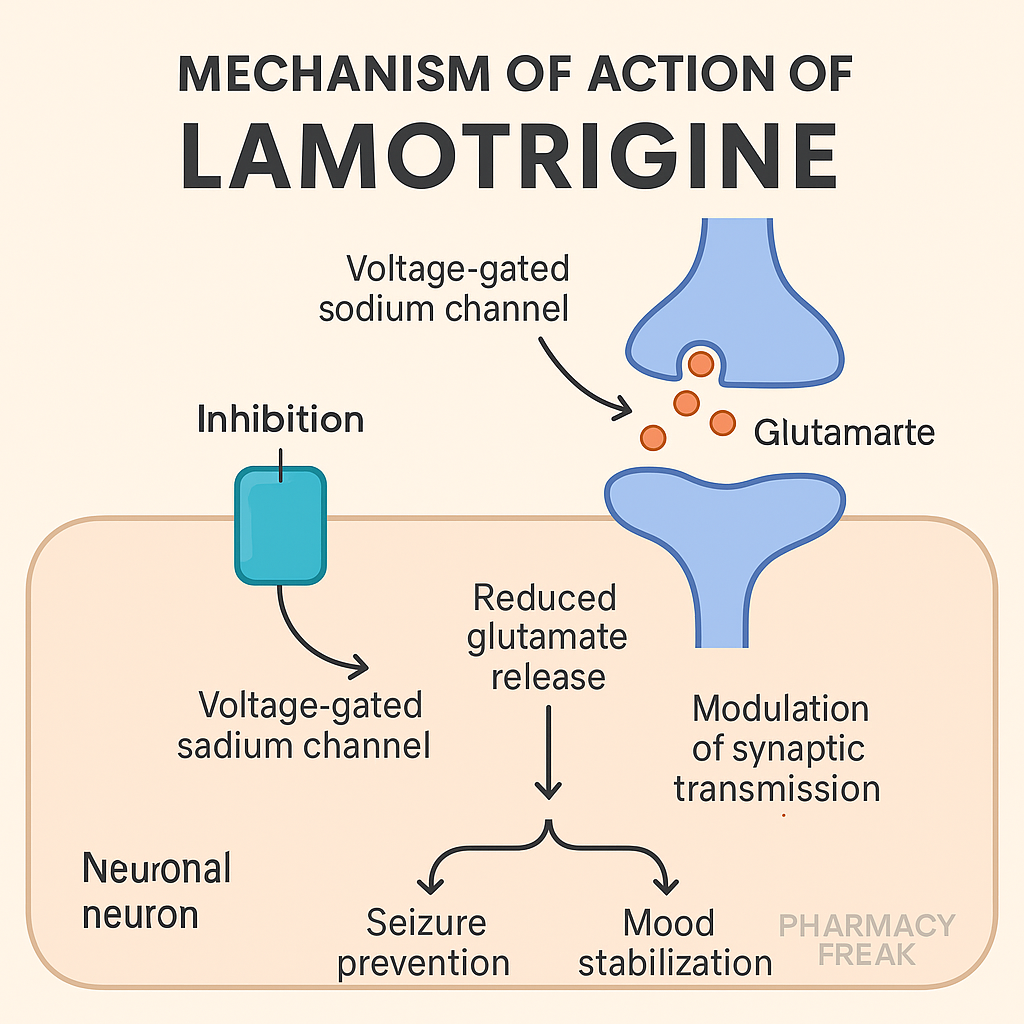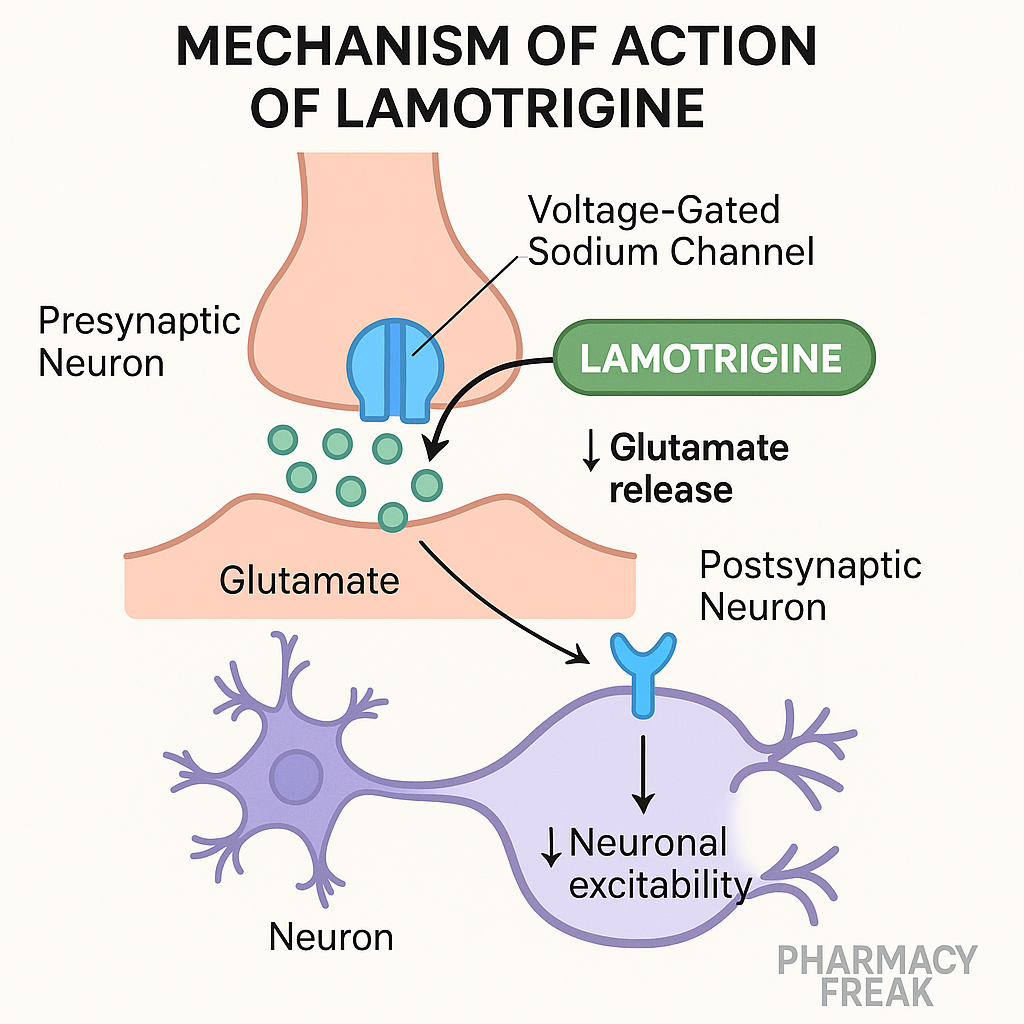Table of Contents
Introduction
Lamotrigine is a broad-spectrum antiepileptic drug (AED) and an effective mood stabilizer, especially in bipolar depression. It is commonly used to treat partial seizures, generalized seizures, Lennox-Gastaut syndrome, and maintenance therapy in bipolar disorder. Lamotrigine has a unique profile with low sedation, minimal weight gain, and fewer cognitive side effects, making it ideal for long-term use.
It’s commonly tested in USMLE, NCLEX, GPAT, and NEET-PG pharmacology modules.
Stepwise Mechanism of Action of Lamotrigine
- Blockade of voltage-gated Na⁺ channels
Lamotrigine stabilizes neuronal membranes by inhibiting voltage-gated sodium channels, thereby reducing neuronal excitability and repetitive firing. - Inhibition of glutamate release
It inhibits presynaptic release of glutamate, an excitatory neurotransmitter involved in seizure generation and mood instability. - Weak inhibition of high-voltage Ca²⁺ channels
Lamotrigine may also mildly inhibit high-voltage-activated calcium channels, further reducing excitatory neurotransmission. - Mood stabilization
The combination of glutamate suppression and Na⁺ channel blockade contributes to mood-stabilizing effects, particularly in bipolar depression.

Pharmacokinetic Parameters of Lamotrigine
| Parameter | Value |
|---|---|
| Bioavailability | ~98% (oral) |
| Half-life | 25–33 hrs (longer if valproate co-administered) |
| Metabolism | Hepatic glucuronidation |
| Drug interactions | Valproate increases levels |
| Excretion | Renal (glucuronide metabolites) |
| Therapeutic range | 1–4 μg/mL (less commonly monitored) |
Clinical Uses of Lamotrigine
- Focal (partial) seizures
- Generalized tonic-clonic seizures
- Lennox-Gastaut syndrome
- Bipolar disorder (maintenance, especially bipolar depression)
- Seizures in pregnancy (preferred AED)
Adverse Effects of Lamotrigine
- Rash – including Stevens-Johnson Syndrome (SJS), especially with rapid dose titration
- Dizziness and ataxia
- Diplopia (double vision)
- Headache
- Nausea and vomiting
- Insomnia
- Rare: Aseptic meningitis
⚠️ Slow dose titration is essential to reduce the risk of serious skin reactions.
Comparative Analysis: Lamotrigine vs Valproate
| Feature | Lamotrigine | Valproate |
|---|---|---|
| Sodium channel block | Yes | Yes |
| Glutamate inhibition | Yes | No |
| Mood effects | Better for bipolar depression | Better for mania |
| Weight gain | Minimal | Common |
| Rash/SJS risk | Higher (rapid titration) | Low |
| Teratogenicity | Low | High (neural tube defects) |
Practice MCQs
Q1. Lamotrigine primarily acts by:
a. Enhancing GABA
b. Blocking NMDA
c. Inhibiting sodium channels ✅
d. Blocking AMPA receptors
Q2. Which neurotransmitter’s release is reduced by lamotrigine?
a. GABA
b. Dopamine
c. Glutamate ✅
d. Serotonin
Q3. Major life-threatening side effect of lamotrigine is:
a. Agranulocytosis
b. Hepatitis
c. Stevens-Johnson Syndrome ✅
d. SIADH
Q4. Lamotrigine is preferred in bipolar disorder for:
a. Mania
b. Mixed states
c. Depression ✅
d. Rapid cycling
Q5. Which drug increases lamotrigine plasma levels?
a. Phenytoin
b. Carbamazepine
c. Valproate ✅
d. Topiramate
Q6. What is the mechanism of rash in lamotrigine toxicity?
a. Immune complex deposition ✅
b. Dopamine release
c. Serotonin excess
d. Renal failure
Q7. Lamotrigine metabolism occurs via:
a. CYP3A4
b. CYP2C9
c. Glucuronidation ✅
d. Deamination
Q8. Which of the following is a benefit of lamotrigine over valproate?
a. Better for mania
b. Less sedation ✅
c. Higher efficacy in seizures
d. Broader spectrum
Q9. Can lamotrigine be used in pregnancy?
a. Never
b. Yes, it’s preferred ✅
c. Only in 3rd trimester
d. Only with folic acid
Q10. Risk of SJS is increased with:
a. Slow titration
b. Co-administration with topiramate
c. Rapid titration ✅
d. Nighttime dosing
FAQs
Q1: Is lamotrigine effective for bipolar mania?
No, it’s not effective in acute mania, but it helps prevent bipolar depression.
Q2: Why should lamotrigine be titrated slowly?
To prevent serious rashes, especially Stevens-Johnson Syndrome.
Q3: Can lamotrigine be combined with valproate?
Yes, but the dose should be reduced, as valproate inhibits its metabolism.
Q4: Is lamotrigine sedating?
No, it’s generally well-tolerated with low sedation.
Q5: What makes lamotrigine suitable in pregnancy?
It has a lower teratogenic risk compared to most other AEDs.
References
- KD Tripathi – Essentials of Medical Pharmacology
- Goodman & Gilman – The Pharmacological Basis of Therapeutics
- Review of Pharmacology – Sparsh Gupta
- NCBI: https://www.ncbi.nlm.nih.gov/books/NBK539794/

I am pursuing MBA in pharmaceutical management from NIPER Hyderabad with a strong academic record and proven success in national-level pharmacy entrance exams. I secured AIR 61 in NIPER 2024 (MS/M.Pharm) and AIR 27 in NIPER MBA, along with AIR 147 in GPAT 2024 and AIR 907 in GPAT 2023. I also achieved AIR 6 in AIIMS CRE-2025 for Drug Store Keeper and was selected as a Pharmacist (AIR 61) for ESIC. Additionally, I was the Runner-Up in Round 2 of the EY Case Study Competition.
At PharmacyFreak.com, I aim to guide future pharmacists through expert content, exam strategies, and insightful resources based on real experience and academic excellence.
Mail- harsh@pharmacyfreak.com
